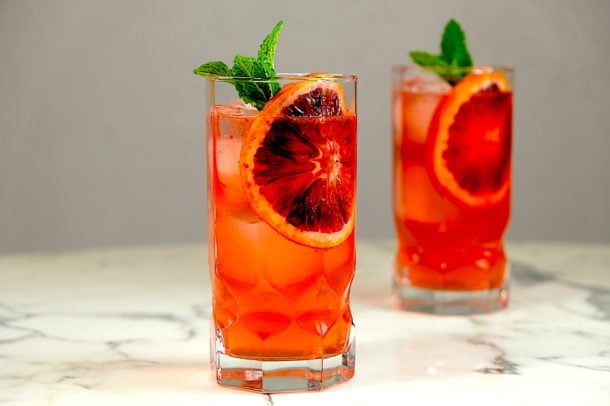The Blood Orange Gin and Tonic was just a spur-of-the-moment experiment. Luckily it turned out to be an excellent combo and a great twist on the classic Gin and Tonic cocktail. And at only 185 Calories, the Gin and Tonic may be the original ‘skinny cocktail’.
Blood oranges not only have a distinctive color, but the dark flesh also has a unique flavor compared to other citrus fruits. A stronger aroma and slightly bitter taste, the orange is accented with a hint of raspberry flavor.
The formula for most gin and tonic recipes is anywhere from 1:1 to 1:3 parts gin to tonic. I like mine somewhere closer to the 1:1 ratio. To be exact my blood orange gin and tonic recipe is 2:3. That being said, please feel free to experiment with the potency of your gin and tonic. Just for show, I add a small amount of Aperol orange liqueur to brighten the color and really drive home the blood orange characteristic.
What is Tonic Water?
Tonic water gets its bitter flavor from Quinine, a medicine used to prevent Malaria. In the 1800s in order to make the quinine more palatable the British military stationed in India, mixed the extremely bitter medicine with seltzer and lemon, thus the birth of ‘Tonic Water’. Today tonic water doesn’t actually have enough quinine in it to be medicinal. The slightly bitter flavor is perfectly combined with gin and blood orange.
The flavorful blood orange juice combined with an herbaceous gin and the bitter characteristics of tonic water create a particularly good Gin and Tonic.
Never Shake Gin Cocktails
Gin has an interesting similarity with red wine and aeration. I’ll use this as an example of why never to shake gin. We are all familiar with the practice of letting red wine ‘breathe’. Decanting red wine, swirling the wine in the glass, and exposing it to oxygen for a short time will soften the flavors. This allows some of the more volatile aromas to escape and release the more pleasant fruit and oak aromas in the wine. However, if allowed to breathe for too long the finer subtle qualities of the wine will not only disappear but eventually, the wine turns to vinegar.
Gin is very similar to red wine in this matter. Shaking gin accelerates the breathing process exponentially.
Gin has a complex mixture of aromas divided into three parts; top notes, middle notes, and base notes. With gin, the most desirable qualities are in the top note. All of the botanicals: juniper, pine, fruit, spice, and floral are top notes. Unfortunately, when gin has been agitated by shaking, the top notes are the first to go. Leaving only the less desirable middle and base notes. Bruising the gin won’t turn it to vinegar, but it will leave the gin dull and lifeless. All of the amazing botanicals that are so desirable lost to the inside of a cocktail shaker.
Here is my Blood Orange Gin and Tonic Recipe:

Blood Orange Gin and Tonic
Ingredients
- 2 Ounces Gin
- 3 Ounces Tonic Water
- 1/2 Ounce Aperol Orange Liqueur
- 1/2 Blood Orange Juice only
Garnish
- 1 Slice Blood Orange
- 1 Sprig Mint
Instructions
- Combine all ingredients in a highball glass, on the rocks
- Garnish with a slice of blood orange and a sprig of fresh mint
